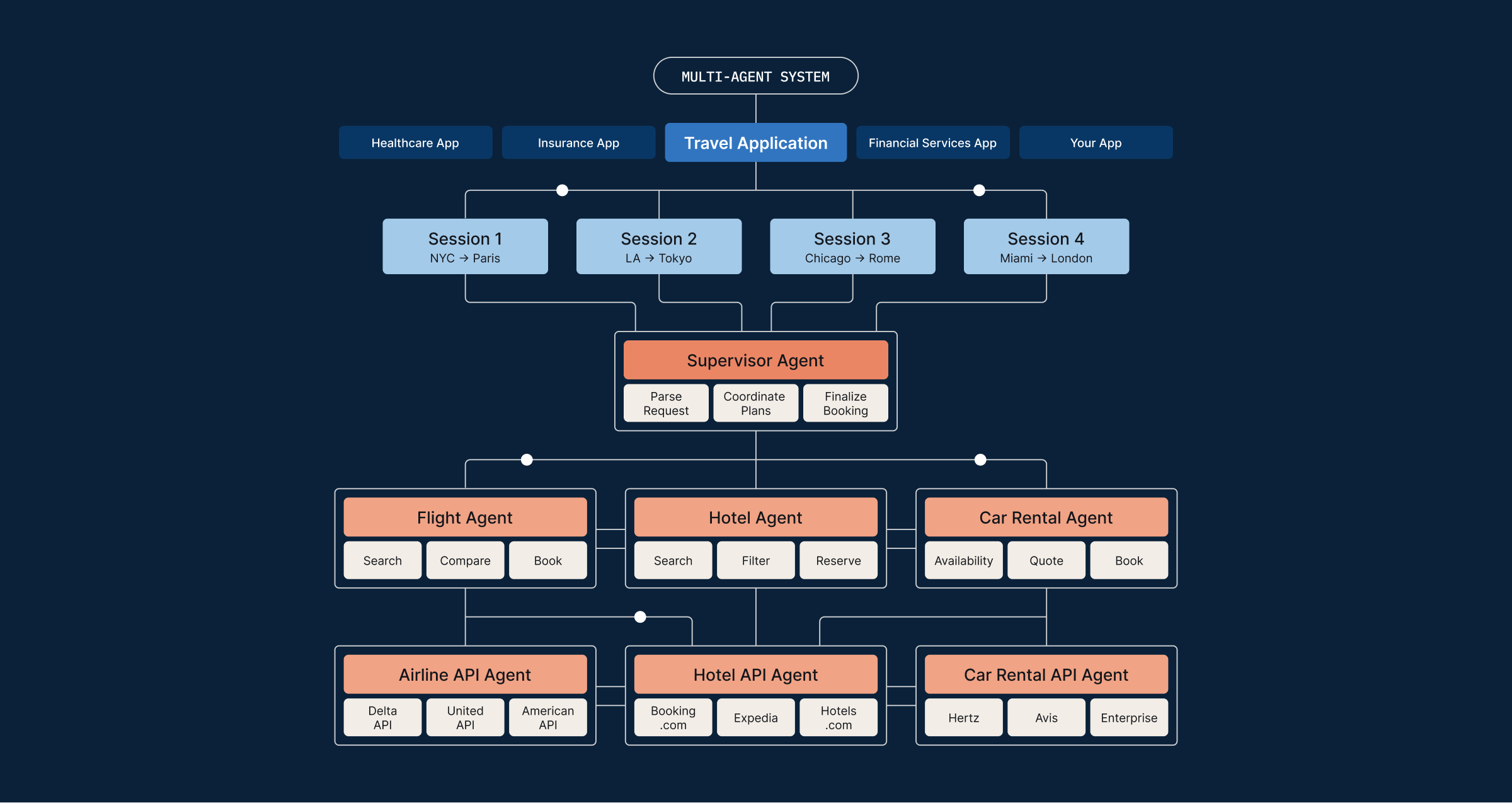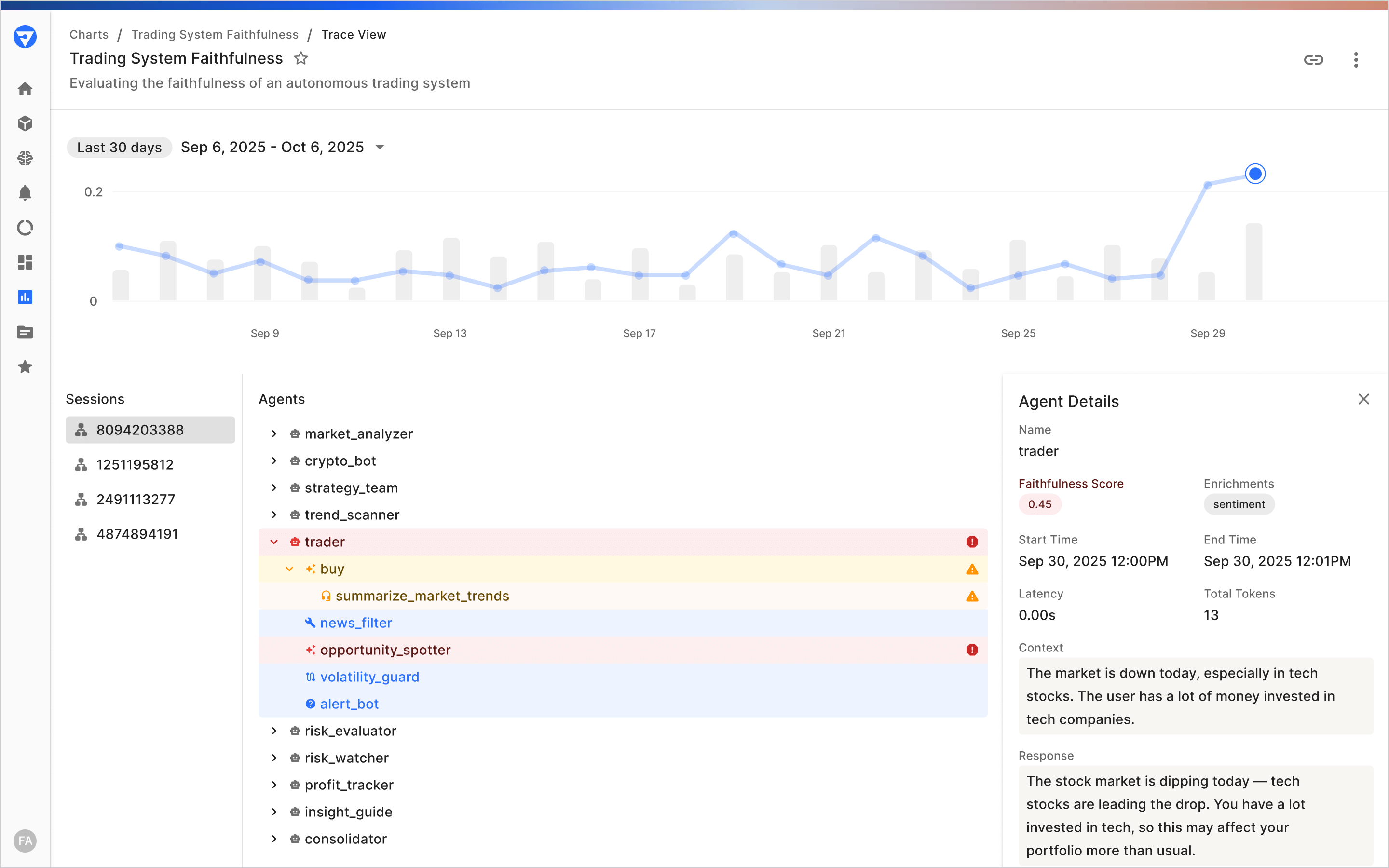Agentic AIOps: The Evolution of AI Agents for Next-Gen Operations with Agentic AI Platforms
Min Read
Traditional AIOps (Artificial Intelligence for IT Operations) introduced automation and analytics into everyday system management. However, as enterprises increasingly adopt large language models (LLMs) and multi-agent frameworks, a new paradigm has emerged: Agentic AIOps.
Agentic AIOps marks the next stage in AI operations, where intelligent agents collaborate, self-optimize, and adapt in real-time. By combining predictive machine learning (ML) models with generative LLMs, these systems can make dynamic, context-aware decisions beyond traditional AIOps’ capabilities. This evolution empowers enterprises to achieve faster, more resilient operations and introduces new complexities that require advanced observability and governance.
Key Takeaways
- Agentic AIOps builds on traditional AIOps using intelligent agents that adapt, collaborate, and make real-time decisions.
- AgentOps ensures control and trust by aligning agent behavior with business goals and monitoring system performance.
- Enterprises face new challenges such as complexity, unpredictability, and transparency gaps, making observability essential.
- Fiddler provides AI agent observability, helping organizations achieve optimal performance, reduce costs, and scale AI safely.
Understanding Agentic AIOps
Agentic AIOps extends the principles of AIOps by embedding AI agents into the operational framework. These agents act as decision-making entities capable of reasoning, coordination, and adaptation, making them valuable for development and operations teams seeking greater efficiency and control.
The key principles of Agentic AIOps include:
- Autonomy: Agents operate with minimal human intervention, making decisions within predefined goals.
- Adaptability: Agents learn from changing environments and optimize performance in real time.
- Collaboration: Multiple agents coordinate workflows across systems, APIs, and datasets.
- Traceability: Enterprises must monitor and understand every agent decision to maintain trust and ensure compliance.
AI agents have evolved from simple chatbots to advanced problem solvers. By combining predictive ML models with LLMs, Agentic AIOps creates context-aware systems that, with performance monitoring tools, give enterprises the visibility needed for accuracy, efficiency, and reliability at scale.
Agentic AIOps vs Traditional AIOps
The table below compares Traditional AIOps, which focuses on efficiency through routine monitoring, with Agentic AIOps, which uses intelligent agents to deliver real-time insights, optimize workflows, and support strategic initiatives.
Autonomous vs. Agentic Systems
People often use autonomous and agentic interchangeably, but they represent distinct concepts.
- Autonomous systems operate independently to complete tasks, but usually follow fixed patterns once deployed. For example, a self-driving car navigates a route without external input, relying on predefined models with limited flexibility in handling generated data.
- Agentic systems go further by reasoning, adapting goals, and coordinating across multiple agents. They process large volumes of operational and raw data, correlating information from diverse sources to deliver actionable insights. For instance, an agentic logistics system might reroute deliveries in real time while factoring in weather, demand, and fuel costs. These systems continuously optimize decisions by applying predictive analytics to drive higher operational efficiency.
The Role of AgentOps in Agentic AIOPs
AgentOps refers to the operational practices and tools used to manage, monitor, and optimize agentic systems. Ensuring that AI agents, often numbering in the dozens or even hundreds, work together seamlessly without compromising safety or efficiency is critical in a modern IT environment.
The key responsibilities of AgentOps include:
- Coordinating multiple agents across workflows and environments
- Ensuring that agentic behaviors remain aligned with enterprise KPIs and system performance requirements
- Monitoring operational data to detect anomalies, performance degradation, or unintended outcomes
- Providing observability and traceability to explain agent decisions

In essence, AgentOps is to Agentic AIOps what DevOps is to software engineering: the backbone of reliable and scalable operations. By enabling enterprises to harness operational data, optimize system performance, and maintain governance across complex agentic workflows, AgentOps ensures that these advanced systems deliver consistent business value.
Challenges in Agentic Systems
Enterprises need to understand Agentic AIOps' challenges to realize its benefits fully.
1. Increased Complexity of Workflows
Agentic systems often combine LLMs and ML models across multiple agents. Their adaptive, non-linear workflows are more complex to design, predict, and troubleshoot.
2. Autonomy and Self-Learning Behaviors
Autonomy drives innovation but also unpredictability. Agents may adapt in ways that diverge from expectations, creating governance and oversight challenges.
3. Lack of Predictability
Traditional AIOps workflows are straightforward, while agentic systems create complex reasoning chains that make decisions difficult to trace and audit.
4. Difficulty in Monitoring and Debugging
In multi-agent environments, cascading failures can spread quickly. A single error may cause service disruptions, and without advanced observability, root cause analysis is slow and error-prone.
Implementing Agentic AIOps
Implementing agentic AIOps in enterprise environments requires a structured approach:
- Assess Readiness: Review current infrastructure and identify where agentic workflows can provide the most significant value.
- Integrate Multi-Model Systems: Combine predictive ML models with reasoning LLMs to strengthen decision-making.
- Adopt AgentOps Practices: Establish observability, governance, and collaboration frameworks to manage complex multi-agent environments.
- Deploy Observability Tools: Use platforms like Fiddler to achieve traceability, detect drift, and ensure that agent behaviors meet compliance requirements.
- Iterate and Optimize: Continuously monitor workflows, refine processes, and address emerging risks to sustain efficiency and resilience.
By following this roadmap, enterprises can accelerate innovation while maintaining control, reliability, and accountability.
Examples of Agentic Behavior in AI
Agentic AIOps is already transforming operations across multiple industries by correlating data from different sources, optimizing resource allocation, and delivering relevant data where needed. These systems improve service management, accelerate incident resolution, and help enterprises reduce operational costs.
Financial Services
AI agents detect fraud by combining predictive ML models with LLMs that explain anomalies in clear, human-readable terms. These systems improve detection accuracy while reducing false positives by correlating data across transactions, customer profiles, and historical patterns.
Healthcare
Multi-agent systems coordinate patient scheduling, diagnostics, and treatment recommendations, adapting in real time to changes in resource availability. Agentic platforms enhance patient outcomes by surfacing the most relevant data to clinicians and administrators while improving overall resource allocation across facilities.
Customer Support
Agentic platforms orchestrate chatbots, knowledge retrieval agents, and escalation workflows to deliver seamless, context-aware customer experiences. By prioritizing relevant data and accelerating incident resolution, they improve service management efficiency while reducing costs associated with manual interventions.
Unlocking the Power of Agentic Observability with Fiddler
The rise of Agentic AIOps brings significant opportunities for enterprises, but it also introduces a new layer of complexity that demands greater visibility, context, and control. Organizations need a platform that delivers clarity and ensures optimal performance across every stage of AI operations to harness the benefits of agentic systems fully.
The Fiddler AI Observability and Security Platform provides that foundation. Built with enterprise-grade Agentic Observability, it acts as a single pane of glass that enables enterprises to see every action, understand every decision, and maintain control across complex multi-agent environments. Unlike traditional AIOps tools, Fiddler connects real-time performance data with decision-making processes, ensuring that AI behaviors remain transparent, accountable, and aligned with business goals.

Fiddler Agentic Observability capabilities include:
- Optimized Workflows: Real-time monitoring in chains of reasoning and workflow logic keeps operations efficient and aligned with objectives.
- Enhanced Decision-Making: Advanced analytics build trust in agent behavior by making reasoning transparent.
- Holistic Visibility: Enterprises gain system-wide insights across sessions, agents, traces, and spans.
- High-Performance Operations: Guardrails with less than 100ms latency support speed without compromising safety.
- Risk Reduction: Early anomaly detection in decision paths help prevent costly disruptions.
- Maximum ROI: AI performance is tied directly to business KPIs, ensuring measurable returns on investment.
- Faster MTTI and MTTR: Traceability tools simplify root cause analysis and accelerate problem-solving.
Ready to take your agentic operations to the next level? Unlock the power of the Fiddler platform’s Agentic Observability to optimize AI operations and enhance decision-making across your enterprise.
Frequently Asked Questions About Agentic AIOps
1. What is the difference between AIOps and agentic AI?
AIOps automates IT operations using AI to improve efficiency and reduce downtime. Agentic AI refers to systems capable of autonomous, adaptive decision-making across complex workflows. Agentic AIOps combines both, bringing adaptive agents into enterprise operations.
2. What does AgentOps do?
AgentOps manages the lifecycle of agentic systems, ensuring that agents operate efficiently, safely, and in alignment with business goals. It includes monitoring, debugging, and governance practices for multi-agent environments.
3. What are examples of agentic behavior?
Examples include AI systems that adjust supply chain logistics in real time, fraud detection systems that combine predictive and explanatory models, or healthcare agents that adapt treatment plans based on evolving patient data.
